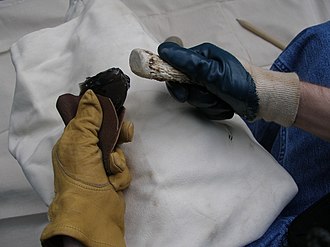AY Honors/Native American Lore/Answer Key
1. Name five uses made of natural materials by the Northwest Indians.
- Vermilion
- Vermilion was used as a red pigment.
- Cedar
- Cedar planks were used for building longhouses.
- Rush
- Mats were made from rush.
- Dog hair
- Hair from a wooly dog bred by these peoples for this purpose was combined with cedar bark and spun into yarn, which was then woven into blankets. They also used down feathers from ducks and geese as well as wool from mountain sheep for this purpose.
- Buffalo hides
- The inland tribes made tipis out of buffalo hides.
2. Name five uses made of the yucca plant by the Southwest Indians.
3. Name five uses made of the birch tree by the Eastern Woodland Indians.
The bark of the Birch tree, especially the Paper Birch, were used for making the outer covering of their canoes. Bark was also used for making bowls and tipis. The bark contains a resinous oil and peels into papery-thin strips which ignite easily with even the slightest spark, and thus, the bark was also used as tinder. The wood of the birch contains the same resinous oil, and burns even when wet. It was therefore used as firewood. Birch bark was also used for making torches which they used for night fishing.
The bark was also used for brewing a wintergreen tea' high in vitamin C. Fans were also manufactured, and were used both for creating a cool breeze and for fanning fires. Birch bark was also used for making armguards and quivers for archery, wrapping food, and rattles.
4. Know 15 plant foods introduced to us by the Indians. Include four plant names used today.
Squash, corn, and beans were known as the "Three Sisters" by Native Americans. The Three Sisters were the three main indigenous plants used for agriculture. These were usually planted together, with the cornstalk providing support for the climbing beans, and shade for the squash. The squash vines provided ground cover to limit weeds. The beans provided nitrogen fixing for all three crops.
Adventist Youth Honors Answer Book/Arts and Crafts/Indian Lore/Foods
5. Describe Indian stalking and tracking.
6. Name five rocks and/or minerals and uses made of them by the Indians.
- Flint, used for making arrowheads, knives, and other cutting tools.
- Obsidian, used the same way as flint.
- Clay, used for making pottery.
- Turquoise, used for adornment
- Argillite, used in art
7. Explain one way in which arrowheads were made by the Indians.
A flintknapper is an individual who shapes flint or other stone through the process of knapping or lithic reduction, to manufacture stone tools.
Knapping is done in a variety of ways depending on the purpose of the final product. For stone tools flint is worked using a fabricator, such as a hammerstone, to remove flakes from a core of tool stone. Stone tools can then be further refined using wood, bone, and antler tools to perform pressure flaking.
There are many different methods of shaping stone into useful tools. The three simplest techniques are mentioned below.
Hard Hammer Precussion
Hard hammer techniques are used to remove large flakes of stone. Early flintknappers and hobbyists replicating their methods often use cobbles of very hard stone, such as quartzite. This technique can be used by flintknappers to remove broad flakes that can be made into smaller tools.
Soft Hammer Precussion
Early flintknappers could have used simple hammers made of wood or antler to shape stone tools. Soft hammer techniques are more precise than hard hammer methods of shaping stone. Soft hammer techniques allow a flintknapper to shape a stone into many different kinds of cutting, scraping, and projectile tools.
Pressure Flaking
Pressure flaking involves removing narrow flakes along the edge of a stone tool. This technique is often used to do detailed thinning and shaping of a stone tool. Pressure flaking involves putting a large amount of force across a region on the edge of the tool and (hopefully) causing a narrow flake to come off of the stone. Modern hobbyists often use pressure flaking tools with a copper or brass tip, but early flintknappers could have used antler tines or a pointed wooden punch.
8. Define pictograph. What are Indian petroglyphs and where can you find them?
9. Describe the use of seashells by the Indians.
10. Name at least ten materials used in making Indian arts and crafts.
11. Make a craft item, using any of the materials named in requirement ten (10).
Note: The official version calls out requirement 9 rather than 10, but this is certainly a typo.







